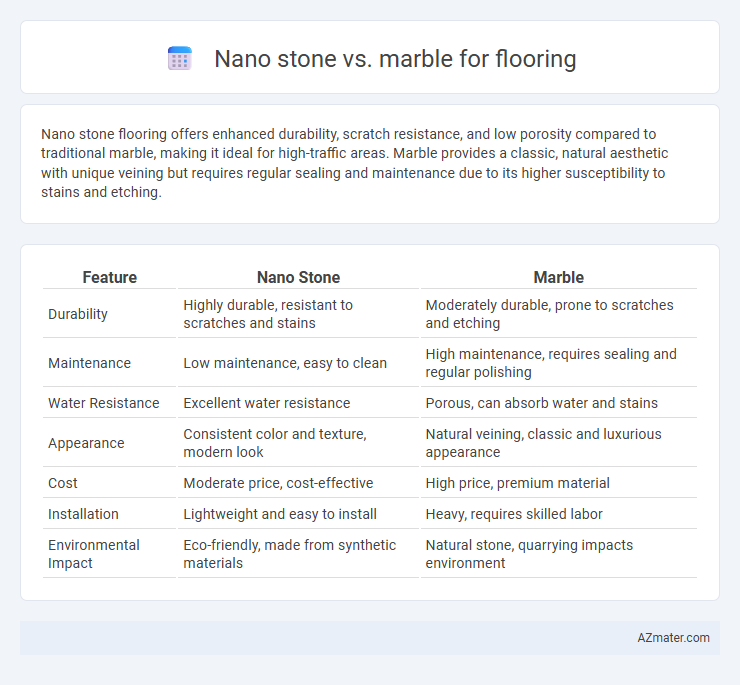Nano stone flooring offers enhanced durability, scratch resistance, and low porosity compared to traditional marble, making it ideal for high-traffic areas. Marble provides a classic, natural aesthetic with unique veining but requires regular sealing and maintenance due to its higher susceptibility to stains and etching.
Table of Comparison
| Feature | Nano Stone | Marble |
|---|---|---|
| Durability | Highly durable, resistant to scratches and stains | Moderately durable, prone to scratches and etching |
| Maintenance | Low maintenance, easy to clean | High maintenance, requires sealing and regular polishing |
| Water Resistance | Excellent water resistance | Porous, can absorb water and stains |
| Appearance | Consistent color and texture, modern look | Natural veining, classic and luxurious appearance |
| Cost | Moderate price, cost-effective | High price, premium material |
| Installation | Lightweight and easy to install | Heavy, requires skilled labor |
| Environmental Impact | Eco-friendly, made from synthetic materials | Natural stone, quarrying impacts environment |
Introduction to Nano Stone and Marble Flooring
Nano stone flooring is engineered with advanced nanotechnology to provide enhanced durability, scratch resistance, and water repellency, making it an ideal choice for high-traffic areas. Marble flooring, a natural metamorphic rock known for its luxurious appearance and unique veining patterns, offers timeless elegance but requires regular maintenance to prevent staining and etching. Both materials serve distinct aesthetic and functional purposes in flooring applications, with nano stone emphasizing performance and marble emphasizing classic beauty.
Composition and Manufacturing Process
Nano stone flooring consists of engineered materials that blend natural minerals like quartz with resins and pigments, resulting in a highly durable, non-porous surface. Marble is a natural metamorphic rock primarily composed of calcite, extracted from quarries and polished to enhance its aesthetic appeal. The manufacturing of nano stone involves high-pressure compaction and advanced curing techniques, whereas marble flooring requires cutting, polishing, and sealing processes to maintain its finish and durability.
Durability and Strength Comparison
Nano stone flooring offers superior durability due to its engineered composition, making it highly resistant to scratches, stains, and impact compared to natural marble. Marble, while aesthetically elegant, tends to be softer and more prone to chipping and erosion over time, especially in high-traffic areas. The enhanced strength of nano stone ensures longer-lasting floors with minimal maintenance, ideal for both residential and commercial applications demanding robust surfaces.
Aesthetic Appeal and Design Versatility
Nano stone offers a sleek, uniform surface with enhanced color consistency and minimal porosity, making it highly resistant to stains and ideal for modern, minimalist flooring designs. Marble presents unique veining patterns and natural variations that create a luxurious, timeless aesthetic, perfect for classic and elegant interiors. While marble boasts unparalleled design exclusivity, nano stone provides greater flexibility in color and texture customization, catering to diverse architectural styles.
Maintenance and Cleaning Requirements
Nano stone flooring offers superior resistance to stains and scratches, requiring minimal maintenance compared to marble, which demands regular sealing and gentle cleaning to prevent etching and discoloration. The non-porous surface of nano stone simplifies cleaning with just mild detergents, while marble's porous nature necessitates specialized cleaners to avoid damage. Nano stone's durability reduces the frequency of repairs, making it a more cost-effective and practical option for high-traffic areas.
Cost Analysis: Nano Stone vs Marble
Nano stone flooring typically costs between $5 and $10 per square foot, making it a budget-friendly option compared to marble, which ranges from $10 to $30 per square foot depending on quality and origin. Installation expenses for nano stone are generally lower due to its easier handling and faster setting times, while marble requires skilled labor and more time, increasing overall costs. Maintenance costs also favor nano stone, as it is more resistant to stains and scratches, reducing long-term expenses compared to the high upkeep needed for marble surfaces.
Environmental Impact and Sustainability
Nano stone flooring offers a more sustainable option compared to marble, as it is often engineered from recycled materials and requires less energy-intensive processing. Marble extraction involves quarrying, which causes significant landscape disruption and higher carbon emissions due to heavy machinery use. Nano stone's durability and lower maintenance also reduce the frequency of replacements, minimizing long-term environmental footprints.
Slip Resistance and Safety Considerations
Nano stone flooring offers superior slip resistance compared to traditional marble, thanks to its enhanced textured surface designed to reduce slipping hazards. Marble, while elegant and durable, can become highly slippery when wet, posing safety risks in residential and commercial spaces. Choosing nano stone improves safety by providing better traction, making it ideal for areas prone to moisture and high foot traffic.
Installation Process and Time
Nano stone flooring offers a streamlined installation process due to its lightweight and durable materials, allowing for quicker handling and placement compared to traditional marble. Marble installation requires careful cutting, sealing, and curing, extending the project timeline significantly. Nano stone typically reduces overall installation time by up to 30%, making it a more efficient choice for both residential and commercial flooring applications.
Conclusion: Which Flooring is Best for Your Space?
Nano stone flooring offers superior durability, scratch resistance, and low maintenance compared to marble, making it ideal for high-traffic or moisture-prone areas. Marble provides timeless elegance and natural veining but requires regular sealing and careful upkeep to prevent staining and etching. Choose nano stone for practical, long-lasting performance and marble for aesthetic luxury and classic appeal in spaces with lighter use.

Infographic: Nano stone vs Marble for Flooring
 azmater.com
azmater.com